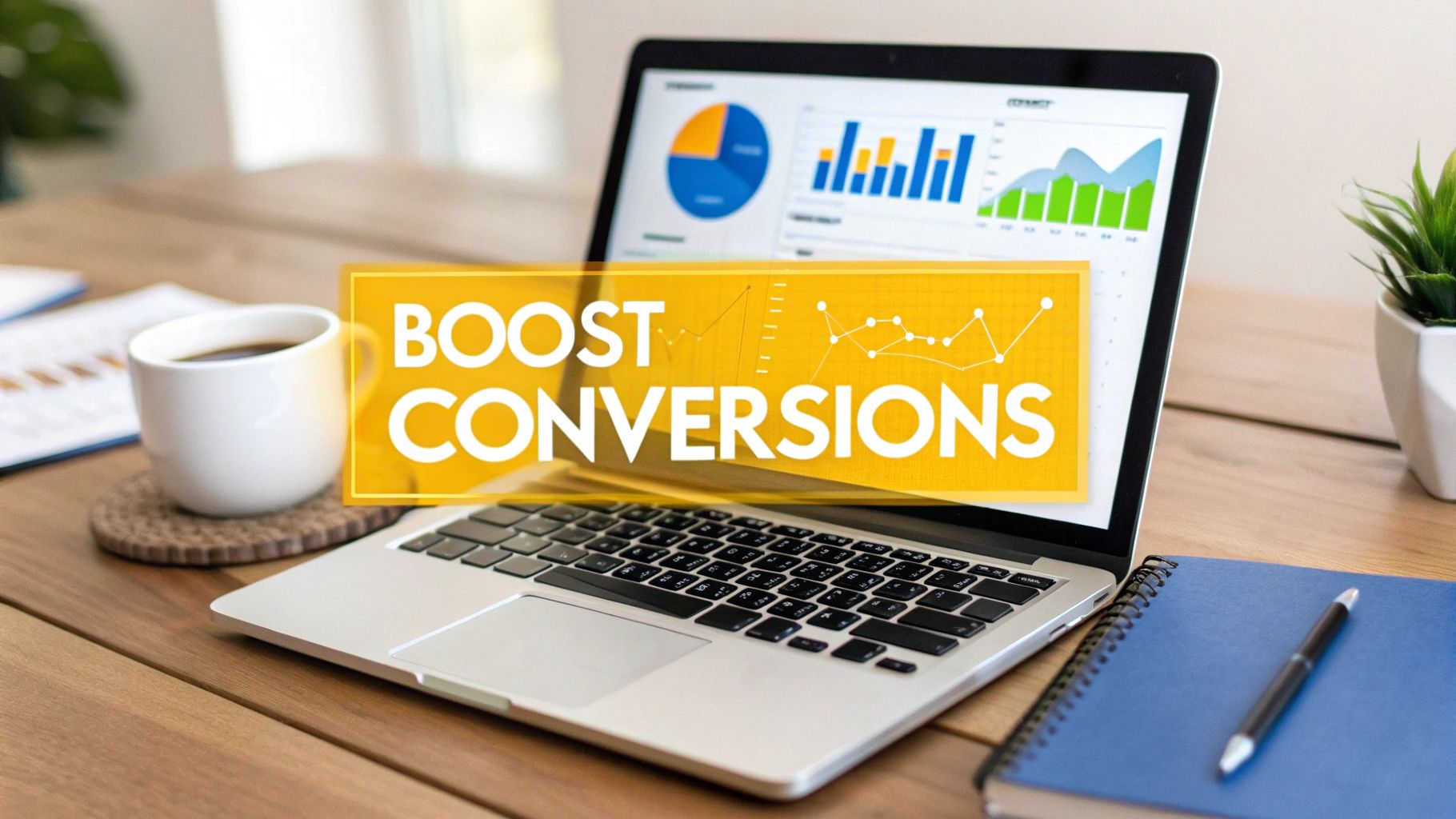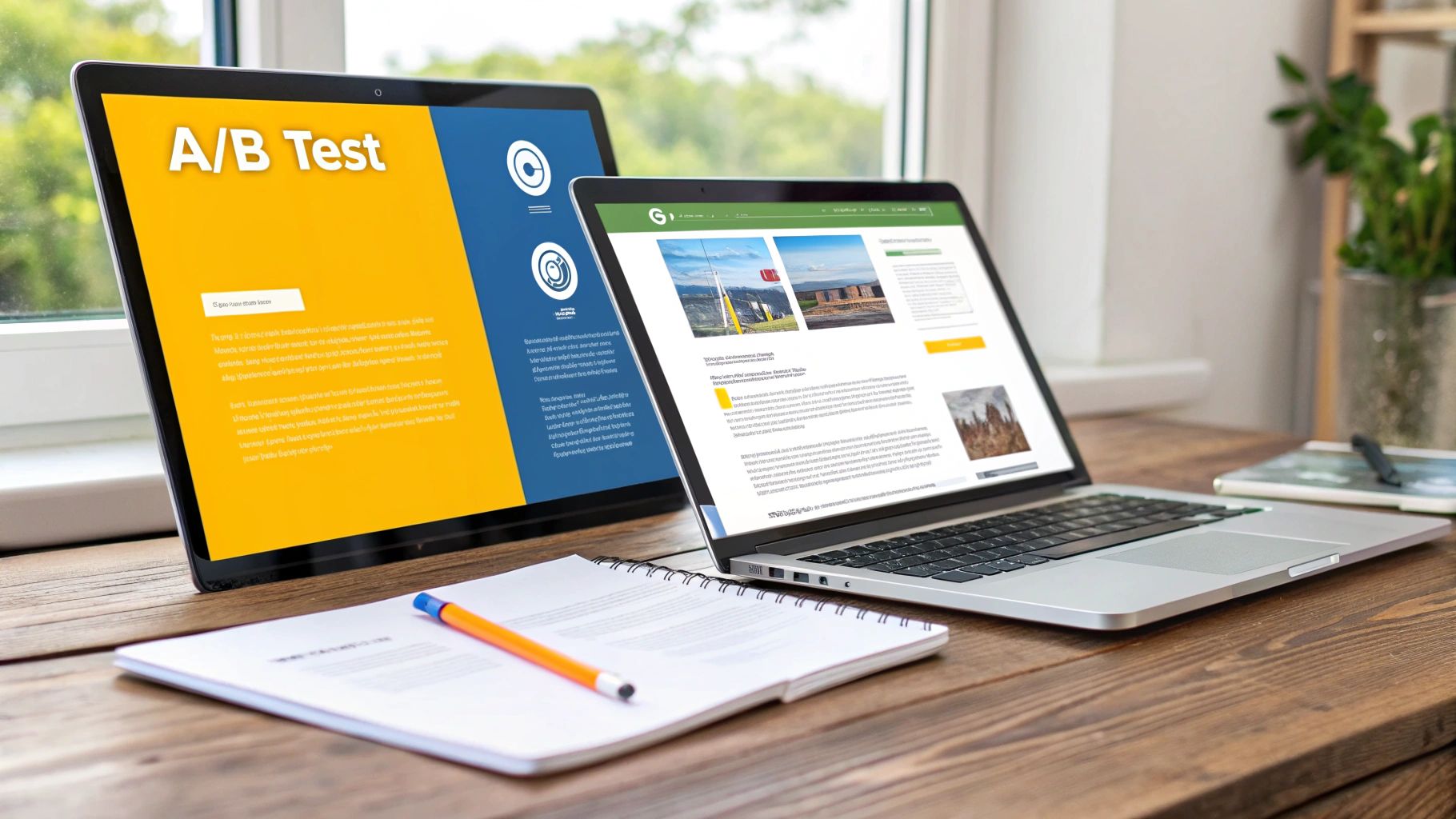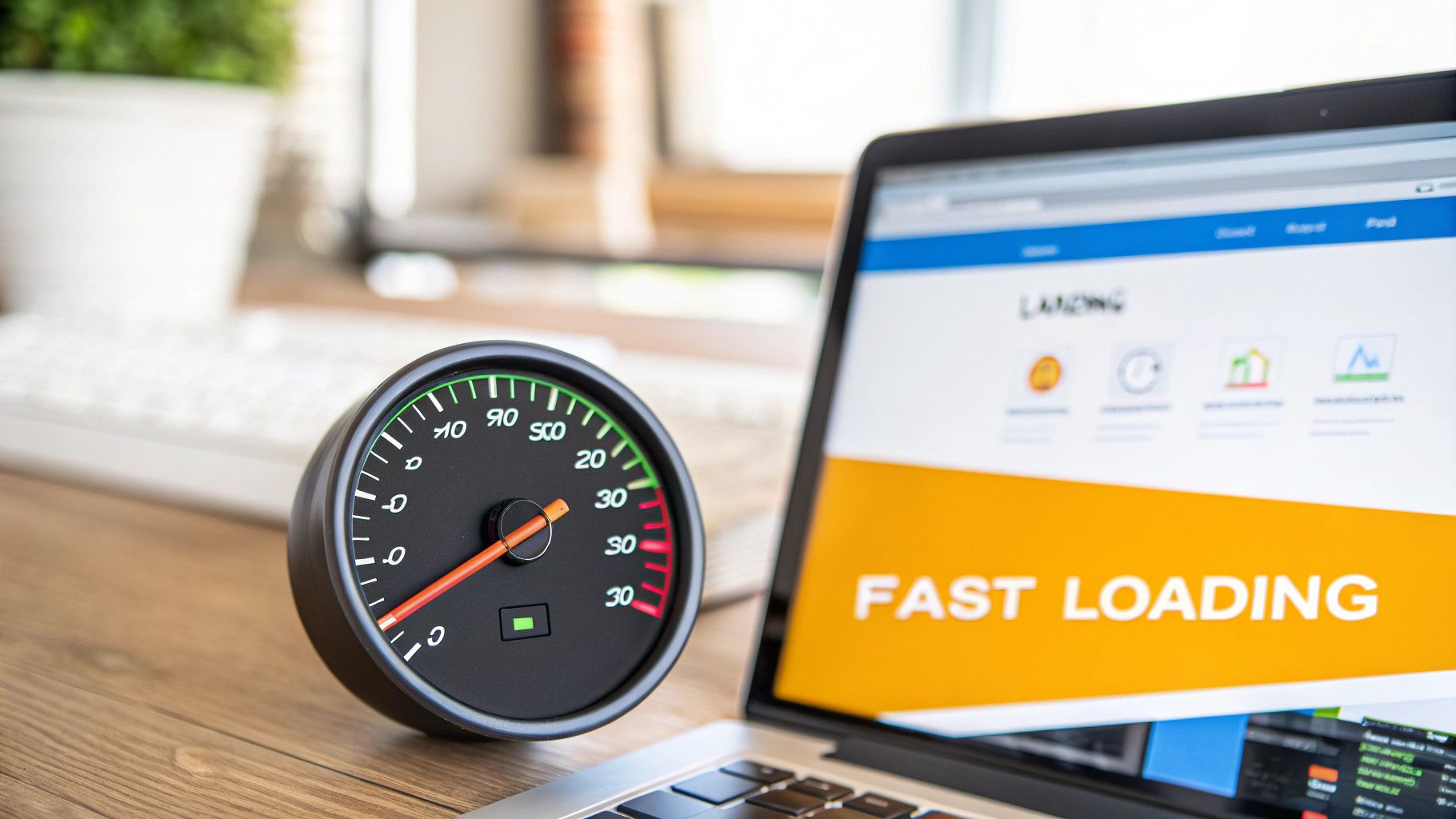How to Increase Website Conversions: Proven Strategies for Success

If you want to increase your website's conversions, you have to start with a simple, powerful truth: first, understand your users, and then make it easier for them to do what you want them to do. It all kicks off by getting your analytics in order to see what people are actually doing on your site. From there, you can spot the friction points and start testing smart changes to smooth out their experience.
Building Your Conversion Intelligence Foundation

Before you can even think about improving your conversion rate, you need to understand where it stands right now. Making tweaks without solid data is like trying to find your way out of a maze with a blindfold on. Sure, you might get lucky, but you’ll waste a ton of time and hit a lot of dead ends along the way.
This first phase is all about building your "conversion intelligence." The goal is to make sure every decision you make from here on out is backed by real evidence, not just a gut feeling. We're not just counting visitors; we're trying to understand their entire journey.
Figure Out What a "Conversion" Really Is
First things first, what does a "conversion" actually mean for your business? It’s almost never just about the final sale. A conversion is any meaningful action a visitor takes on your site.
I always recommend tracking a mix of goals to get the full story:
- Macro-conversions: These are your big-ticket items. Think a completed purchase on an e-commerce site or a submitted quote request form for a service business. They're the primary objectives.
- Micro-conversions: These are the smaller, but still valuable, steps a user might take. This could be anything from signing up for your newsletter, downloading a whitepaper, or even just watching a product demo video.
Tracking both is non-negotiable. Why? Because micro-conversions are your leading indicators. They show you who's getting interested and where your marketing is hitting the mark, even if that person isn't ready to buy today. Get these set up as goals in your analytics platform, like Google Analytics 4, from day one.
Go Beyond the Numbers and See What Users See
Standard analytics are great at telling you what happened, but they often leave you guessing about the why. To really understand how to boost your conversions, you need to see your website through your visitors' eyes. This is where qualitative tools are a game-changer.
A real-world example: I once worked with an e-commerce client who was tearing their hair out over a high bounce rate on their product pages. The data showed people were leaving, but it didn't say why. We installed a heatmap and, within a day, had our answer. Over 80% of clicks were on the manufacturer's logo, which wasn't clickable. Users were desperately trying to find more brand information, and we were failing to provide it.
Heatmaps are fantastic for showing you where people click, how far they scroll, and what they ignore. But session recordings take it to another level. These are video-like replays of actual user sessions. Honestly, sitting down and watching a handful of these is one of the most eye-opening things you can do. You’ll spot bugs, confusing navigation, and other frustration points you never would have noticed otherwise.
Your Essential Toolkit for Analysis
To build a solid foundation for your CRO efforts, you need the right tools. Each gives you a different piece of the puzzle, and when you put them together, you get a powerful, comprehensive view of user behavior.
Before we dive in, let’s look at the key tools you'll want in your arsenal. The table below breaks down the must-have categories and what they do.
| Essential Conversion Tracking Tools | ||
|---|---|---|
| Tool Category | Primary Function | Example Tools |
| Web Analytics | Tracks quantitative data like traffic sources, user demographics, and goal completions. | Google Analytics 4, Adobe Analytics |
| Behavior Analytics | Provides qualitative insights through heatmaps, scroll maps, and session recordings. | Hotjar, Crazy Egg, Microsoft Clarity |
| A/B Testing | Allows you to test variations of pages to see which one performs better. | VWO, Optimizely |
Your first priority should always be getting a web analytics platform set up correctly. Once that's tracking your goals, layering in behavior analytics tools like Hotjar or Microsoft Clarity will give you the "why" behind your numbers.
This powerful combination is what creates true conversion intelligence. It allows you to form smart, data-driven hypotheses for A/B tests, ensuring your efforts to increase website conversions are strategic and impactful, not just random shots in the dark.
Connect With Your Most Valuable Visitors

To really move the needle on conversions, you have to accept one simple truth: not all traffic is created equal. A wave of new visitors is great, but it doesn't mean much if they aren't the right visitors. The real breakthrough comes when you stop chasing raw traffic numbers and start focusing on quality—finding out which channels bring you the people who are ready to act.
Think about the difference in mindset. Someone who clicks a link in your email newsletter already knows you and trusts you enough to subscribe. They're warm. Compare that to someone who stumbles onto your site from a broad social media ad. They’re probably just browsing. If you treat both of these visitors the same way, you’re leaving money on the table.
Dig Into Your Traffic Sources
Your first stop should be your analytics dashboard. Pop open your acquisition reports and get a clear picture of where your traffic is coming from. You’ll see the usual suspects: organic search, paid search, social media, email, referrals, and direct traffic. Don't just look at which channel sends the most people. Look at which one sends the people who actually convert.
I once worked with a SaaS company that was burning through their budget on paid social ads. The campaign was generating a ton of clicks, which looked great on paper, but their free trial sign-ups were completely flat. When we segmented their conversions by source, the problem became obvious. While social media drove 40% of their traffic, it was responsible for a measly 5% of their trial sign-ups. At the same time, their organic search traffic was converting at nearly four times that rate. That single insight changed everything.
By reallocating a chunk of their paid social budget to SEO and content, they doubled their qualified leads in just three months—without spending a dollar more on marketing. That's the power of knowing where your best customers are hiding.
This kind of analysis shows you exactly where your gold is.
How Different Channels Actually Perform
The performance gap between channels isn't just a theory; it's a well-documented reality. A user’s intent and their existing relationship with your brand have a huge impact on whether they’ll convert.
For example, direct traffic—people who type your URL right into their browser or use a bookmark—often has the highest conversion rate, around 3.3%. Why? Because they already know who you are and have a reason to come back. Email marketing is right behind it, converting at 2.8% because you're talking to a pre-qualified, engaged audience. SEO leads convert at a solid 2.3% by catching people with active search intent, while paid search brings in a 1.5% conversion rate. You can find more conversion rate benchmarks across channels to see how you stack up.
Knowing these averages helps you set realistic goals and tells you where to point your optimization efforts for the biggest impact.
Match Your Message to the Visitor
Once you know where your best traffic comes from, the next move is to create a journey that speaks directly to them. This is where tailored landing pages and message match become your secret weapons. The promise that brought someone to your site must align perfectly with what they see when they land.
Paid Ad Visitors: If someone clicks your ad promoting a "50% Off Spring Sale," the landing page they hit better have that offer front and center. The headline, hero image, and CTA should all scream "50% Off Spring Sale."
Organic Search Visitors: Someone coming from Google after searching "how to choose the best running shoes" is in research mode, not buying mode. Don't hit them with a hard sell. Greet them with a helpful guide or an interactive quiz that helps them find the right shoe. You're meeting their informational need first.
Email Subscribers: A click from an email about a "new product launch" should lead to a page all about that new product. Give them the details, show off the features, and provide a clear path to purchase.
By personalizing the experience this way, you remove friction and make the user feel understood. You’re acknowledging where they came from and what they want, guiding them much more effectively toward your goal. This is how you turn a generic website into a powerful, persuasive tool for your most valuable visitors.
Designing a Frictionless User Experience
A clunky, frustrating user experience is the fastest way to kill your conversion rate. When visitors can't find what they need or are stuck waiting for a page to load, they don't just get annoyed—they leave. Designing a "frictionless" experience is all about proactively removing those roadblocks, making the journey from curious visitor to happy customer as smooth as possible.
From my experience, when I’m brought in to fix a low-converting website, I almost always start by looking at three things: site speed, the mobile experience, and how intuitive the navigation is. If you can get these three fundamentals right, you build a foundation of trust that naturally guides users toward your goals.
The High Cost of a Slow Website
Your website’s load speed is one of the most critical—and surprisingly neglected—factors in conversion optimization. We live in a world of instant gratification, and every single second counts. A slow site doesn't just test a user's patience; it actively costs you real money by driving away potential customers before they even see what you're offering.
The data on this is impossible to ignore. There's a direct, measurable link between load time and conversion rates. A website that loads in just one second can see conversion rates up to three times higher than a site that takes five seconds. The difference is even more dramatic when compared to a site that takes ten seconds, where faster sites can have conversion rates five times higher. It's clear: speed isn't just a nice-to-have, it's a foundational requirement for success.
A great first step is to run your site through a tool like Google's PageSpeed Insights. It gives you a clear baseline score for both mobile and desktop.

The report won't just give you a score; it will hand you a to-do list with specific opportunities, like compressing images or improving server response times, that are holding your site back.
Crafting a Flawless Mobile Experience
In this day and age, having a "mobile-friendly" site isn't enough. You need to aim for a mobile-first experience that feels completely natural on a smaller screen. With well over half of all web traffic now coming from mobile devices, a clunky mobile interface is a surefire way to alienate a massive chunk of your audience.
A truly responsive design is much more than just a shrunken-down version of your desktop site. It requires rethinking the entire user journey from a mobile perspective.
- Simplify Your Navigation: That complex desktop menu needs to go. Replace it with a clean, tappable "hamburger" menu and make sure there's plenty of space around buttons to prevent fat-finger mistakes.
- Streamline Your Forms: Mobile forms must be brutally short and simple. Use features like autofill and make sure the numeric keypad pops up for phone number fields to make life easier for your users.
- Optimize for Touch: Every interactive element has to be designed for fingers, not a precise mouse cursor. Think big, obvious call-to-action buttons that are impossible to miss and easy to tap.
Key takeaway: Mobile users are often on the go, distracted, and task-oriented. They need to find information and get things done fast. Your mobile design must put speed and clarity above everything else.
Guiding Users with Clear Navigation and CTAs
Think of your website's navigation as its roadmap. If the map is confusing or hard to read, your visitors will get lost and frustrated. Intuitive navigation and crystal-clear calls-to-action (CTAs) work hand-in-hand to guide users exactly where you want them to go, which eliminates confusion and builds their confidence in your brand.
A good navigation structure just feels right. It's predictable. People shouldn't have to hunt for your services, pricing, or contact info. Stick to a simple main menu that uses plain, everyday language. This isn't the place for clever jargon—use "Contact Us" instead of something cutesy like "Let's Talk."
This same dedication to clarity has to apply to your CTAs. Every single page should have a primary CTA that tells the user precisely what to do next.
CTA Best Practices:
- Use Action-Oriented Language: Always start with a verb. "Get Your Free Quote" is far more compelling than a passive word like "Submit."
- Make Them Visually Prominent: Your CTA buttons need to pop. Use a strong, contrasting color that draws the eye and makes them impossible to overlook.
- Be Specific: The text on the button should clearly describe the outcome. "Download the eBook" is much better than a vague "Click Here."
Finally, a truly frictionless experience is an inclusive one. Making sure your site is accessible to people with disabilities is not only the right thing to do, but it also expands your potential customer base. You can dig into the specifics in our guide on how to make your website accessible. By focusing on a fast, mobile-first, and clear user experience, you're paving a smooth, direct path to conversion.
Crafting Compelling Content That Converts

Once your site is technically sound and easy for people to use, it's your words that have to do the heavy lifting. Every headline, button, and product description on your website is essentially your 24/7 digital salesperson. To get more conversions, that salesperson needs to be persuasive, trustworthy, and incredibly clear about the value you're offering.
It’s easy to fall into the trap of talking all about yourself—listing features, boasting about your company's history, or using industry jargon that means nothing to your audience. The reality is, your visitor only has one question running through their mind: "What's in it for me?" Your content's primary job is to answer that question, loud and clear.
Speak to Their Problems, Sell Them the Solution
Great copy doesn't just sell products; it sells a better version of the customer. It's about the transformation they'll experience, not the transaction itself. To get this right, you have to shift your thinking from features to benefits. A feature is what your product is; a benefit is what the customer gets.
Think about it this way:
- Feature: Our vacuum cleaner is equipped with a HEPA filter.
- Benefit: You can breathe cleaner, allergen-free air in your home.
See the difference? The benefit connects directly to a real human desire. To start writing copy that resonates, you first need to get inside your audience's head. What are their biggest frustrations? What problems are keeping them up at night? Your content should frame your product or service as the clearest, most direct path to solving that exact problem.
Here's a powerful little secret: if you can describe your customer's problem better than they can themselves, you create an instant bond. When a visitor reads your copy and thinks, "Wow, they really get me," you've built trust and made them far more open to hearing about your solution.
This approach should be the foundation of your content. If you want to see how this plays out in a full strategy, checking out some content marketing strategy examples can show you how to build your messaging around your audience's needs.
Build Unshakable Trust with Social Proof
Let's be honest—no matter how convincing your own words are, people will always trust other customers more. That's the power of social proof. It’s real-world validation that you can actually deliver on your promises. When you place social proof strategically across your site, you can dissolve a customer's doubt right at the moment they're making a decision.
Social proof comes in many flavors. Here are some of the most effective:
- Customer Testimonials: Short, powerful quotes that show a specific result are gold. Ditch the generic "Great service!" and aim for things like, "Their team helped us boost our leads by 40% in just two months."
- Case Studies: These are in-depth stories that walk through how you took a customer from a point of struggle to a point of success. They are absolute conversion machines, especially for B2B.
- Reviews and Ratings: Those little star ratings are a quick visual signal of quality. For e-commerce sites, they're non-negotiable.
- Trust Badges: Think logos of well-known clients you've worked with, security seals (like SSL certificates), or industry awards. They all build credibility at a glance.
Try placing testimonials near your call-to-action buttons or pricing tables. Feature case studies prominently on your service pages. The goal is to anticipate a visitor's skepticism and have a peer-endorsed answer ready for them.
Create an Offer They Can’t Refuse
At the end of the day, even the best copy and the strongest trust signals won't mean a thing without a compelling offer. Your offer is the specific deal you're putting on the table. To make it irresistible, you need to combine incredible value with a gentle nudge to act now. This is where a little psychology comes in.
The Anatomy of a High-Converting Offer
| Trigger | What It Is | How It Looks |
|---|---|---|
| Value | The customer must feel like they are getting way more than what they're giving up (whether it's money, time, or info). | "Get our $297 marketing course for free when you sign up." |
| Urgency | A time-based reason to take action. This is fantastic for overcoming procrastination. | "This offer ends Friday at midnight." or "Last day for 50% off!" |
| Scarcity | A quantity-based reason to take action. It signals that the opportunity is limited and might disappear. | "Only 3 spots left at this price." or "Limited edition run of 100." |
When used ethically, these triggers create a powerful reason for someone to convert. You’re not just asking them to buy; you're giving them an exciting, time-sensitive reason to do it right away. This is how you turn static website pages into active, growth-driving machines.
Building a Culture of Continuous Optimization
Improving your conversion rate isn't a "one and done" task you can just check off your to-do list. The businesses that truly pull ahead are the ones that treat it as a constant cycle of testing, learning, and refining. This is the point where you shift from just plugging obvious leaks to actively hunting for new opportunities. You're building a culture of experimentation where every change is a chance to get better.
The engine of this culture is A/B testing, sometimes called split testing. It’s a straightforward but incredibly powerful way to compare two versions of a webpage—the original (your "control") and a new variation (the "challenger")—to see which one actually performs better. By showing each version to a different slice of your audience, you get cold, hard data on what truly works, not just what you think works.
Forming a Hypothesis From Your Data
A good A/B test never, ever starts with a random guess like, "I bet a green button would be cool." It always starts with a strong, data-driven hypothesis. All that foundational work you did—poring over heatmaps, watching session recordings, and slicing up your traffic segments—is what fuels these educated guesses.
A rock-solid hypothesis usually follows a simple framework: "If I change [X], then [Y] will happen, because [Z]."
- [X] is the change: For example, swapping a feature-based headline for one that highlights a key benefit.
- [Y] is the expected outcome: More people will click the "Add to Cart" button.
- [Z] is the reason: The new headline does a better job of explaining the product's value, which should boost motivation.
This structure forces you to tie your idea to a specific metric and a logical "why." This is a crucial part of any solid digital marketing plan template because it keeps your tests strategic, not just a series of random shots in the dark.
Here's a pro-tip: A great hypothesis is specific and measurable. For instance: "By changing our CTA button text from 'Submit' to 'Get Your Free Guide,' we will increase form submissions by 15% because the new text is more specific and instantly communicates value."
Designing and Running a Clean Test
Once you have your hypothesis, you need to design a clean experiment that gives you results you can trust. The whole point is to isolate your variable. You need to be sure that any lift in conversions came from the one thing you changed, not some other random factor.
What should you test? Here are some ideas, from small tweaks to bigger swings:
- Headlines and Subheadings: Does a benefit-focused headline outperform one that just lists features?
- Call-to-Action (CTA) Buttons: Test the color, size, and especially the text. "Get Started" vs. "Create My Account" can make a world of difference.
- Images and Videos: Does a short product video convert better than a carousel of static images?
- Form Fields: Could you get more signups just by removing one non-essential field? (The answer is often yes.)
- Page Layout: This is a much bigger test, but you could pit a single-column layout against a traditional two-column design.
- Offers: Test a 20% Off discount against a Free Shipping offer to see which incentive resonates more with your audience.
When you launch the test, you have to let it run long enough to reach statistical significance. This is a fancy way of saying you have enough data to be confident the result isn't a fluke. Most A/B testing tools, like VWO or Optimizely, will flag this for you, usually when you hit a 95% confidence level.
Interpreting Results and When to Go Bigger
Looking at the results isn't just about crowning a winner. It's about learning. If your variation wins, awesome—roll it out! But if it loses, or if the result is flat, you need to dig into the why. Did your change accidentally confuse people? Did it draw their eyes away from another important element? Every test, win or lose, gives you an insight you didn't have before.
For businesses with a lot of traffic, it can sometimes make sense to run multivariate tests. While a standard A/B test compares two completely different versions (A vs. B), a multivariate test lets you try out multiple small changes all at once. For instance, you could test two headlines, three images, and two button colors simultaneously to find the absolute best combination. It's more complex and requires a ton of traffic, but it can be a powerful way to fine-tune a high-stakes page.
Ultimately, building this culture means your whole team starts asking, "Could we test that?" It shifts the company mindset from relying on opinions to demanding evidence, ensuring your efforts to increase website conversions become a consistent, data-driven engine for growth.
Answering Your Top CRO Questions
Even with a great plan in hand, you're bound to have questions as you start digging into your site's performance. It happens to everyone. Let's walk through some of the most common questions I get from clients to clear up any confusion and keep you moving forward.
What Is a Good Website Conversion Rate?
This is the million-dollar question, isn't it? The most honest—and useful—answer is that it really depends. You'll see averages like 2-5% quoted all over the internet, but a "good" rate is completely relative to your industry, traffic source, and what you're selling.
Think about it: an e-commerce brand selling trendy t-shirts will naturally have a different conversion benchmark than a B2B company selling complex enterprise software. The sales cycles and price points are worlds apart.
Your best benchmark is yourself. Instead of getting hung up on an arbitrary industry average, focus on steady, incremental improvement over your own historical data. If you converted at 1.5% last quarter, getting to 1.8% this quarter is a fantastic, meaningful win.
How Long Until I See Conversion Results?
The timeline for seeing a real impact from your efforts can be all over the map. It really boils down to two things: how much traffic your site gets and how big of a change you're making.
Sometimes, a simple, high-impact fix can show results almost overnight. I've seen clients clarify a confusing headline on a key landing page and see a measurable lift in just a couple of days. That’s the dream scenario.
On the other hand, more complex tests, like completely overhauling a multi-step checkout process, will take time. You'll need weeks, maybe even months, to collect enough data to know for sure if the new version is a winner. The key is to aim for sustained growth, not just one flashy, quick win.
Should I Focus on Traffic or Conversions First?
For almost any business that already has a website up and running, the answer is a no-brainer: focus on conversions first.
Driving more traffic to a website that struggles to convert is like pouring water into a leaky bucket. You’re just wasting time and money attracting visitors who are destined to bounce.
Fixing the leaks in your conversion funnel is almost always the more cost-effective move. Think about the math: doubling your conversion rate from 1% to 2% literally doubles your business from the same amount of traffic. That kind of improvement has the same bottom-line impact as doubling your ad spend, but it's usually much cheaper and more sustainable to achieve.
Patch up the holes in your bucket first. Once your site is a well-oiled machine for turning visitors into customers, every dollar you spend on traffic becomes exponentially more valuable.